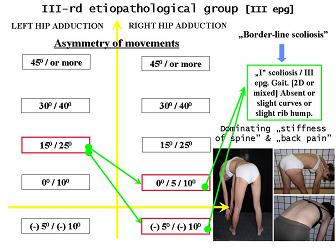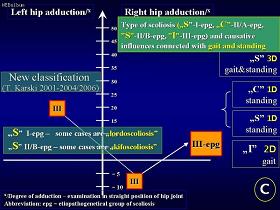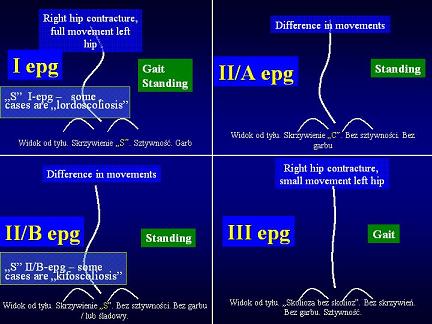 |
So-called idiopathic scoliosis |  |
| SKOLIOZA / SCOLIOSIS | (3) Types of scoliosis |  POLISH VERSION POLISH VERSION |
Partner / książki / books: 
|
(3) Three types of scoliosis, two sub-types - NEW CLASSIFICATION (2001 - 2004/2006).
Recent information about problem of so-called idiopathic scoliosis in chapter (click) "FOTOS/PHOTOS/WYKLADY/LECTURES" (left) - next look in subchapters (green) with words LECTURE / LECTURES - especially look (click) "Lectures in REGENSBURG, 12th May 2007, LECTURE in Min. Zdrowia / Ministry of Health in Warsaw on 19th June 2007 for VIP on orthopadics in Poland (!?), with many DOCUMENTS from abroad (e.g. from prof. Hans Mau - Tubingen / Germany, Prof. Georg Neff - Berlin / Germany, Dr. med. Renate Tomaschewski & Barbara Popp - Germany, prof. G. Burwell - UK, Prof. P. Dangerfield - UK, Prof. Alan Gardner - UK, Prof. Franz Grill - Austria, Prof. J. Breitenfelder - Germany, Prof. Kazimierz Rąpała - Warsaw / Otwock / Poland, Prof. Kennth Cheung - Hong Kong / China, Prof. Ian Stokes - USA, Prof. Marc Asher - Kansas / USA, Prof. Martha Hawes - Arizona / USA, Prof. Stephan Eisenstein - UK, Prof. Viktor Bialik - Hajfa / Israel, Prof. John Sevastik - Sweden, Prof. Bo Sevastik - Sweden, Prof. Milan Kokavec - Bratislava / Slovak Republic, Prof. Lubos Rehak - Bratislava / Slovak Republic, Dr Peter Tisovsky - Bratislava / Slovak Republic, Prof. Ivo Marik - Prague / Czech Republic, Prof. K. Żołyński - Łódź / Poland and other) and also the others LECTURES like in Liverpool 2008 or in Cairo 2008.
[1] Explanation of development of so-called idiopathic scoliosis - new classification: [0ABC] Zgodnie z koncepcją biomechaniczną powstawania skoliozy symetryczny zakres addukcji obu bioder (badanie w wyproście stawu) chroni kręgosłup przed powstaniem deformacji. Przy symetrii ruchów bioder brak wpływu związanego z chodzeniem oraz związanego "ze staniem na spocznij na prawej nodze".
(
(B)1 II/A epg - "C" - left convex L or S-L or L-Th scoliosis [by some authors often described as "paretic scoliosis (?!) - my answer - no - it is a special type of "so-called idiopathic scoliosis" - others authors speak about "degenerative scoliosis in adults" (?!) - my answer - yes - but "degenerative" after many years - in age of 40 - 50 - 60 years. On the picture on the right there is shown the X-ray of a female-patient 66 years old. Primary she had "C" scoliosis in II/A group. The patients with "degenerative scoliosis (!?)" primary could also have "S" scoliosis from / in II/B group]. Primary cause - "standing at ease" only on the right leg for many years. Clinically and in X-ray the curve is possible to see - only at the age of 10 - 12 - 13 years - earlier there is only physiogical side movement / deviation of axis, later - "C" scoliosis. No or very small progression.
Beginning of spine deformity in every type of scoliosis starts in children - age 2 - 3 - 4, if they starts to "stand 'at easy' on right leg" and starts more to "walk" (!).
[2] New classification. Three groups of scoliosis, two sub-types. Importance and influences: gait and standing "at ease" on the right leg. Short repetition of the description from the (1) chapter "So-called idiopathic scoliosis".
Connection with the "gait and standing" - see the "picture" with scoliosis types/on x-ray picture - "S" I epg, 'C' II/A epg, "S" II/B epg and "I" III epg - on main page in "English Version". Here look especially on the range of the adduction movement of right and left hip.
Ist epg "S" shaped scoliosis, connection with gait and permanent standing "at ease" on the right leg (see picture down)
IInd/A epg "C" shaped scoliosis, connection with the permanent standing "at ease" on the right leg (see picture down)
IInd/B epg "S" shaped scoliosis, connection with the permanent standing "at ease" on the right leg. Children with "laxity of joints", often after bad/harmful exercises (see picture down)
IIIrd epg "I" shaped scoliosis ("scoliosis without curves" - discussion in Hong Kong 2004 with Prof. Keith Luk & Prof. Kenneth Cheung about "scoliosis" without "scoliosis"), connection only with gait (see picture down)
More about the three types/groups of scoliosis in "Scoliosis in English" or "Skoliose in Deutsch" (click on the link on the left). See also - chapter "FOTOS/PHOTOS/WYKŁADY/LECTURES" (left) - next many LECTURES. |
|||||||||||||||||||||||||||||||||||||||||||||||||||||||||||||||||||||||||||||||||||||||||||||||||||
| Data modyfikacji: 2012-10-14 | Strona przygotowana przez Prof. dr med. Tomasza Karskiego | |||
 |
 |





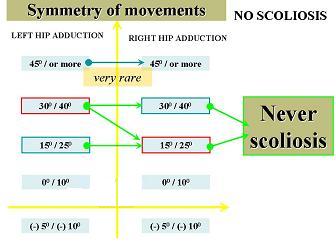
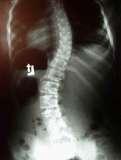
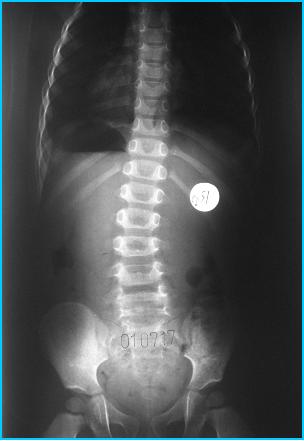 A) I-st etiopathological group (Iepg) - "S" double scoliosis with gibbus costalis (rib prominence). Some cases in this group are called in orthopaedic literature "Lordoscoliosis". These types of scoliosis is characterised by early beginning (scoliosis develop when the child start to "stand" and start to "walk"), first rotation deformity with "stiffness of spine", later / or contemporary - deformity in "saggital plane" (explanation: decreasing of thoracic kyphosis or sometimes with "lordotic deformity" of thoracic spine and decreasing of lumbar lordosis), next deformity in "frontal plane" (curves). According to American Academy of Orthopaedic Surgeons in cooperation with the Scoliosis Research Society (SRS) doctors can spaek about "so-called idiopathic scoliosis" when the curves are 20 degrees or more (Cobb), according to Prof. Daniel Zarzycki from Zakopane / Poland can speak when there are 15 degrees or more (Cobb), according to the Internet / Web Sites when the are 10 degrees or more (Cobb), according to me (T.Karski) when there are 5 degrees or less [Cobb] (!) - see the picture above on left side (!). Cause in this group - connection with the gait and permanent "standing at ease" only on the right leg for many years. Progression.
A) I-st etiopathological group (Iepg) - "S" double scoliosis with gibbus costalis (rib prominence). Some cases in this group are called in orthopaedic literature "Lordoscoliosis". These types of scoliosis is characterised by early beginning (scoliosis develop when the child start to "stand" and start to "walk"), first rotation deformity with "stiffness of spine", later / or contemporary - deformity in "saggital plane" (explanation: decreasing of thoracic kyphosis or sometimes with "lordotic deformity" of thoracic spine and decreasing of lumbar lordosis), next deformity in "frontal plane" (curves). According to American Academy of Orthopaedic Surgeons in cooperation with the Scoliosis Research Society (SRS) doctors can spaek about "so-called idiopathic scoliosis" when the curves are 20 degrees or more (Cobb), according to Prof. Daniel Zarzycki from Zakopane / Poland can speak when there are 15 degrees or more (Cobb), according to the Internet / Web Sites when the are 10 degrees or more (Cobb), according to me (T.Karski) when there are 5 degrees or less [Cobb] (!) - see the picture above on left side (!). Cause in this group - connection with the gait and permanent "standing at ease" only on the right leg for many years. Progression. 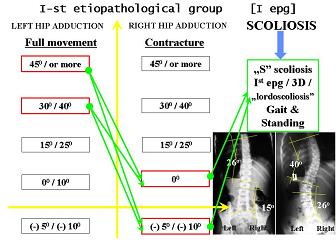
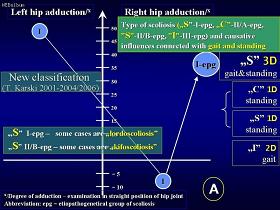
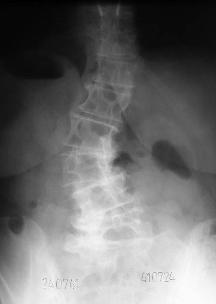
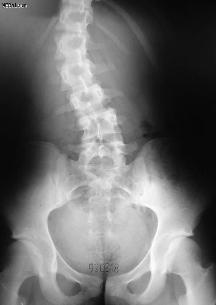
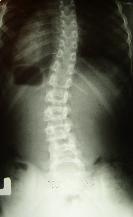
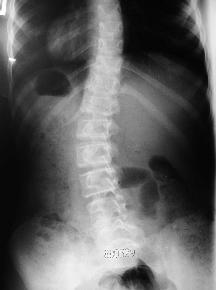 (B)2 II/B epg - "S" - left convex lumbar scoliosis is the primary deformity and thoracic right convex scoliosis is secondary. Some cases in this group are called in orthopaedic literature "Ky(i)phoscoliosis". Primary cause - "standing at ease" only on the right leg for many years. In children with "S" scoliosis-II/B epg often exist laxity of joints and such deformity is also a result of "wrong (old) exercises"(!). This type of "S" - II/B epg scoliosis form - is found only in connection with "standing at ease" on the right leg. The confirmation of this sub-group (2003/2006) is based on the large number of case studies from 1995 - 2006 [N - 1300]. In this type "S" II/B epg scoliosis
(B)2 II/B epg - "S" - left convex lumbar scoliosis is the primary deformity and thoracic right convex scoliosis is secondary. Some cases in this group are called in orthopaedic literature "Ky(i)phoscoliosis". Primary cause - "standing at ease" only on the right leg for many years. In children with "S" scoliosis-II/B epg often exist laxity of joints and such deformity is also a result of "wrong (old) exercises"(!). This type of "S" - II/B epg scoliosis form - is found only in connection with "standing at ease" on the right leg. The confirmation of this sub-group (2003/2006) is based on the large number of case studies from 1995 - 2006 [N - 1300]. In this type "S" II/B epg scoliosis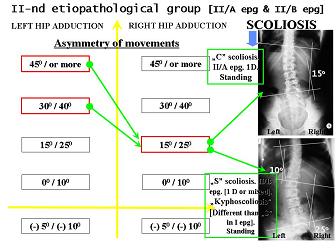
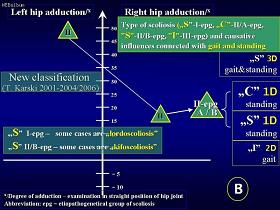
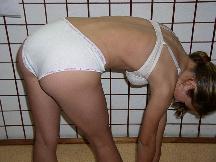
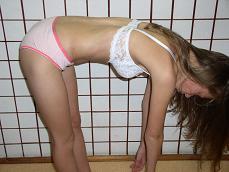 (C) III epg - "I" - scoliosis with "stiff spine" - without any/or big curves and without any/or big gibbus costalis, often "back pain", no progression. Cause - connection only with the gait. In this group does not exist (or is very small) the influence connected with the "standing at ease" on the right leg. Why? Because the stability of left leg is similar to the stability of right leg during standing. See the "first picture" on the main page of "English Version". - is shown "the range of movement of both hips". Such type of scoliosis becomes a problem in adults because of pain. Such types of scoliosis need differential diagnosis and orthopaedic examination for the patients treated because of "back pain". Very often these patients search for help in Departments of Neurology, Gynecology, Interna, Cardiology, Rheumatology, even Pediatrics. Youth have the problem with sport because of rigidity of spine. Such type of scoliosis is without progression.
(C) III epg - "I" - scoliosis with "stiff spine" - without any/or big curves and without any/or big gibbus costalis, often "back pain", no progression. Cause - connection only with the gait. In this group does not exist (or is very small) the influence connected with the "standing at ease" on the right leg. Why? Because the stability of left leg is similar to the stability of right leg during standing. See the "first picture" on the main page of "English Version". - is shown "the range of movement of both hips". Such type of scoliosis becomes a problem in adults because of pain. Such types of scoliosis need differential diagnosis and orthopaedic examination for the patients treated because of "back pain". Very often these patients search for help in Departments of Neurology, Gynecology, Interna, Cardiology, Rheumatology, even Pediatrics. Youth have the problem with sport because of rigidity of spine. Such type of scoliosis is without progression. 